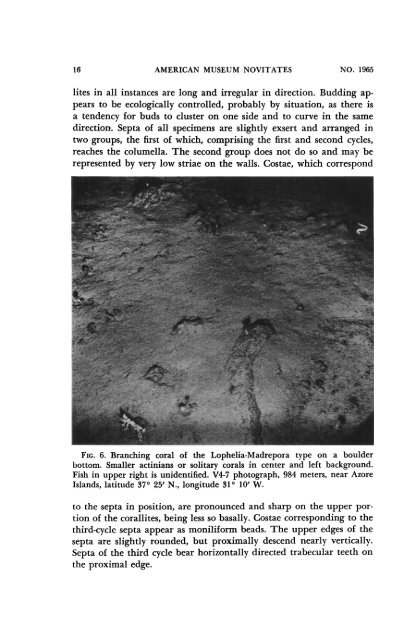MXieuicanJAuscum - American Museum of Natural History
MXieuicanJAuscum - American Museum of Natural History
MXieuicanJAuscum - American Museum of Natural History
Create successful ePaper yourself
Turn your PDF publications into a flip-book with our unique Google optimized e-Paper software.
16<br />
AMERICAN MUSEUM NOVITATES<br />
NO. 1965<br />
lites in all instances are long and irregular in direction. Budding appears<br />
to be ecologically controlled, probably by situation, as there is<br />
a tendency for buds to cluster on one side and to curve in the same<br />
direction. Septa <strong>of</strong> all specimens are slightly exsert and arranged in<br />
two groups, the first <strong>of</strong> which, comprising the first and second cycles,<br />
reaches the columella. The second group does not do so and may be<br />
represented by very low striae on the walls. Costae, which correspond<br />
FIG. 6. Branching coral <strong>of</strong> the Lophelia-Madrepora type on a boulder<br />
bottom. Smaller actinians or solitary corals in center and left background.<br />
Fish in upper right is unidentified. V4-7 photograph, 984 meters, near Azore<br />
Islands, latitude 370 25' N., longitude 310 10' W.<br />
to the septa in position, are pronounced and sharp on the upper portion<br />
<strong>of</strong> the corallites, being less so basally. Costae corresponding to the<br />
third-cycle septa appear as moniliform beads. The upper edges <strong>of</strong> the<br />
septa are slightly rounded, but proximally descend nearly vertically.<br />
Septa <strong>of</strong> the third cycle bear horizontally directed trabecular teeth on<br />
the proximal edge.
















